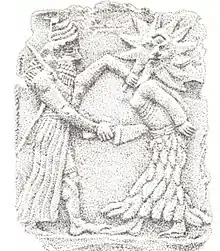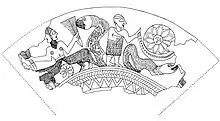'Ain Samiya goblet
The 'Ain Samiya Goblet is a silver cup from the Middle Bronze Age I (2300-2000 BC), found in a tomb at Ain Samiya near modern Ramallah. It depicts a double-headed god with an animal body planting crops and the dead body of a serpent, parts of whom are being held by two male figures. The scenes depicted have brought scholarly parallels to the Babylonian creation epic, the Enuma Elish and the defeat of Tiamat by the Babylonian patron deity, Marduk. The goblet demonstrates clear influences from Mesopotamia on Proto-Canaanite culture and shares other parallels with contemporary depictions like the Khafaje plaque during its Babylonian occupation.[1][2]

Khafaje plaque with similar iconography found in Mesopotamia from the Isin-Larsa period around the same time as the goblet

A flat rendering of the scenes depicted on the Ain Samiya Goblet
References
- YADIN, Y. (1971). "A Note on the Scenes Depicted on the 'Ain-Samiya Cup". Israel Exploration Journal. 21 (2/3): 82–85. ISSN 0021-2059.
- "Rare goblet". www.imj.org.il. 2022-04-06. Retrieved 2022-04-20.
This article is issued from Wikipedia. The text is licensed under Creative Commons - Attribution - Sharealike. Additional terms may apply for the media files.